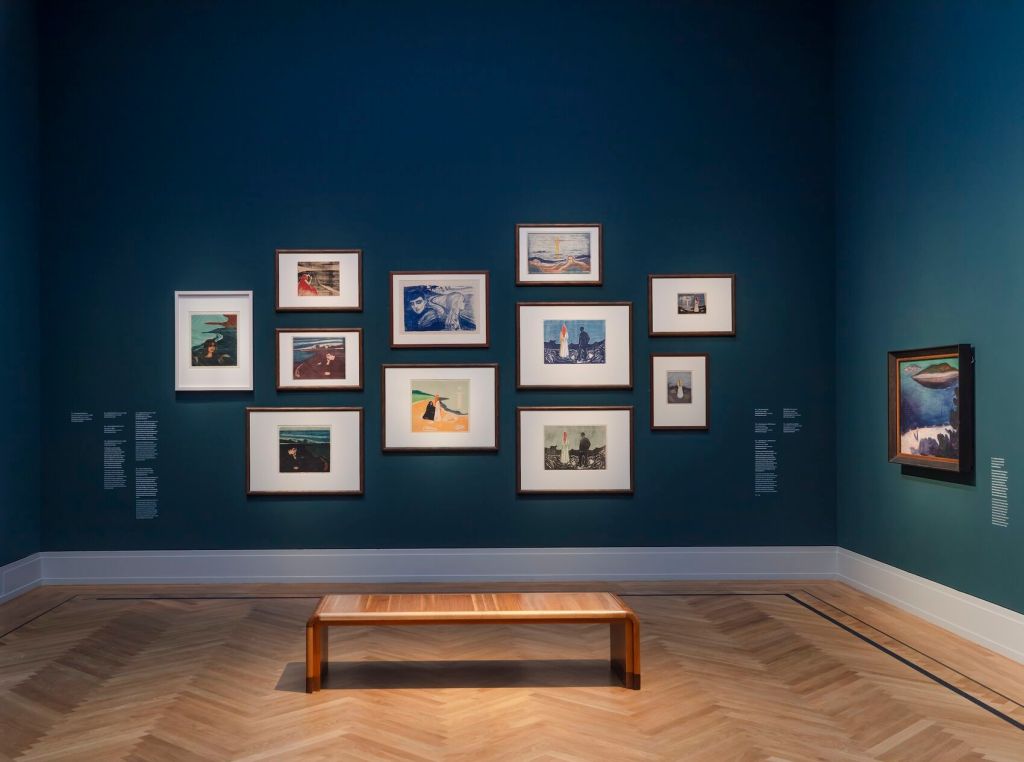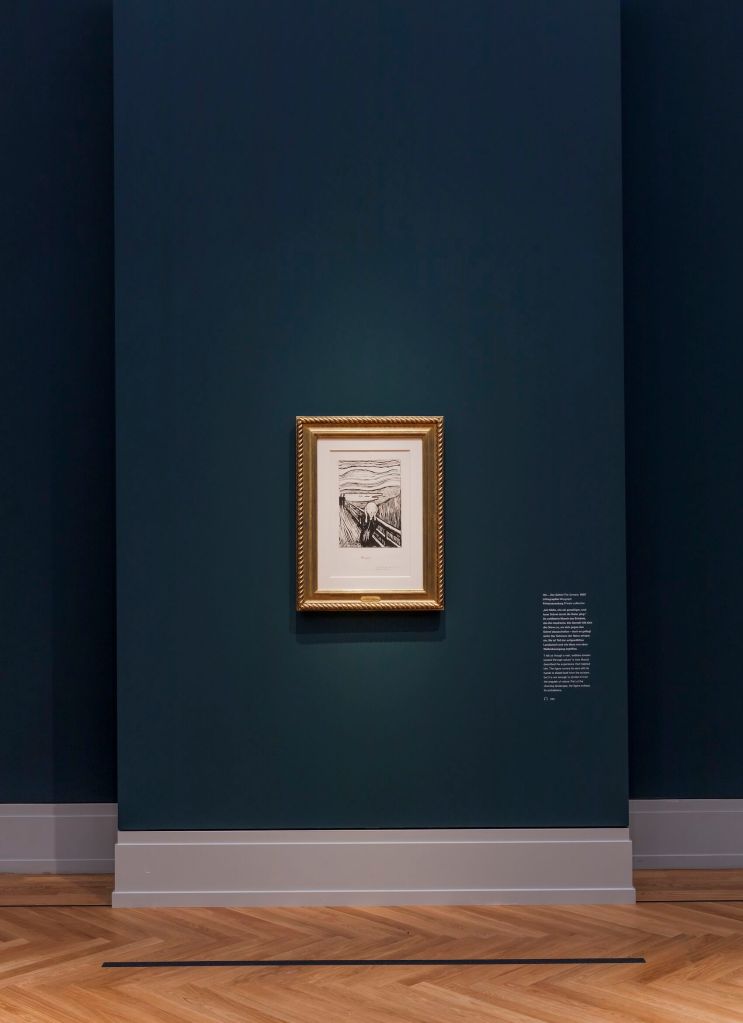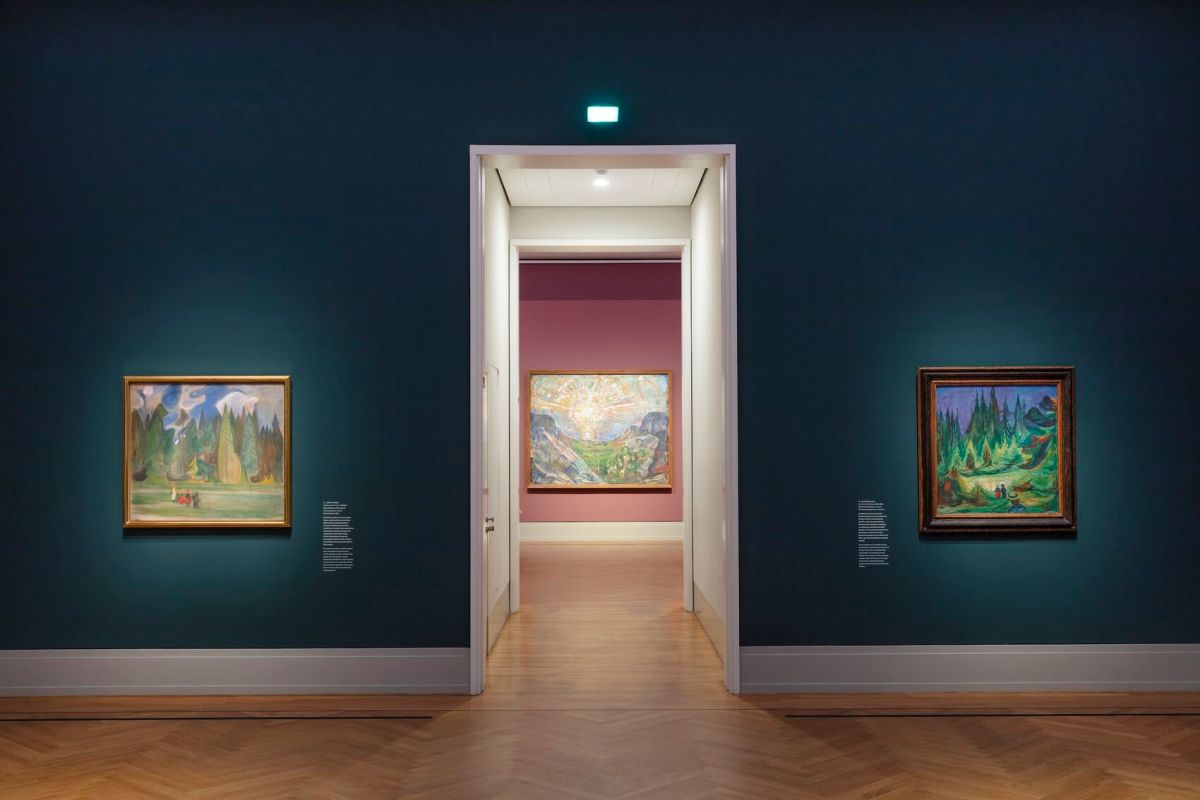The Museum Barberini in Potsdam is currently showcasing the exhibition:
Edvard Munch: Trembling Earth
The exhibition is scheduled to run until April 1st, 2024.

Edvard Munch: Trembling Earth
© David von Becker
On November 18, the exhibition Edvard Munch: Trembling Earth was opened at the Museum Barberini. Organized in cooperation with the Clark Art Institute in Williamstown, USA, and the MUNCH in Oslo, the exhibition is the first to focus on Edvard Munch’s fascination with nature. The show features over 110 works by the Norwegian artist, with some of his most famous motifs as well as unknown works. Also on view are the monumental preliminary studies for Munch’s paintings for the Aula at the University of Oslo, which have not been exhibited in Germany for over a century. Lenders include the MUNCH in Oslo, the Museum of Modern Art in New York, the Dallas Museum of Art in Texas, the Musée d’Orsay in Paris, the Museum Folkwang in Essen, the Kupferstichkabinett of the Staatliche Museen zu Berlin, and the Von der Heydt Museum in Wuppertal. The exhibition in Potsdam is curated by guest curator Jill Lloyd, an expert on modern European art.
The first exhibition of Edvard Munch’s landscapes
Edvard Munch is known for his haunting images of primal human emotion. His interest in the psychological dimensions of existence, however, was matched by an equally strong fascination with nature. Employing his unique sensibility and power of imagination, Munch explored motifs taken from nature, seeking to fathom humanity’s place in the cosmic cycle of life. The image of the landscape in Munch’s work, however, has received little systematic attention up to this point. Now for the first time, the exhibition Edvard Munch: Trembling Earth and the accompanying catalogue investigate the meaning of such images in Munch’s oeuvre, questioning common assumptions and examining the contemporaneous artistic, scientific, and philosophical influences that contributed to his understanding of nature. With motifs ranging from undulating coastlines and fairy-tale forests to snow-covered or stormy landscapes, luxuriant gardens, and the exuberant play of sun, air, and water, Munch’s work also resonates with the present-day climate crisis against the backdrop of current natural catastrophes.
“Although Edvard Munch devoted almost half of his works to motifs from nature, until now he has not been perceived as a landscape painter. With Edvard Munch: Trembling Earth, our desire is to open up this perspective on his work,” says Ortrud Westheider, director of the Museum Barberini. “Especially in conjunction with the Impressionist landscapes in the Hasso Plattner Collection, it is fascinating to see how Munch, a Norwegian contemporary of the Impressionists, connected landscape with the inner life and how such different perspectives on nature could develop at the same time in Europe. While the goal of the Impressionists was to recreate the sensory experience of nature through light and color, for Munch nature was always also a mirror of his own inner turmoil, giving his landscape images a greater sense of drama. We are especially fortunate that the exhibition Edvard Munch: Magic of the North at the Berlinische Galerie overlaps with our Munch show for eight weeks. The public thus has the opportunity to experience the dimensions of the oeuvre of one of the most important artists of the modern era in all its facets in both Berlin and Potsdam. With the preliminary works for the Aula paintings, which were exhibited at the Berlin Secession in 1913 and were enthusiastically received by audiences in Berlin, we also have a direct thematic connection to the exhibition of our Berlin colleagues.”
116 paintings, woodcuts, lithographs, and drawings from twenty-one lenders in eight exhibition chapters

Edvard Munch: Trembling Earth
© David von Becker
From June 10 to October 15, 2023, the exhibition was on view at its first station, the Clark Art Institute in Williamstown, Massachusetts. Curated by Jay A. Clark, it received outstanding reviews: “A revelatory exhibit” (The Wall Street Journal); “Magnificent . . . Munch the landscapist coexists with the connoisseur of affliction” (Financial Times); “Glorious . . . It’s a revelation” (The Atlantic); “a major modern painter in a new, broader, enlivening light” (The New York Times). The Potsdam exhibition, curated by guest curator Jill Lloyd, features 116 works in eight exhibition chapters. In late April 2024, the show will travel to its third station, the MUNCH in Oslo, where it will be curated by Trine Otte Bak Nielsen.
The chapters of the exhibition engage with a variety of natural spaces to explore the active role played by the landscape in the art of Edvard Munch. While the chapter In the Forest exemplifies Munch’s sense of nature as a mysterious realm and a place of romantic growth and decay, the chapter Garden and Field reveals his fascination with the interaction between humanity and nature. In Between Land and Sea, coastal landscapes serve as a backdrop for separation, attraction, and solitude, while the beaches of Åsgårdstrand, Warnemünde, Hvitsten, and Ekely—locations where Munch lived and worked for many years—symbolize a Summer Retreat. The chapter The Scream of Nature addresses existential questions of the relationship between man and nature: here, a lithograph of what is probably Munch’s most famous work, The Scream, is juxtaposed with the explosive color of his monumental painting The Sun. The chapter Storm and Snow explores the degree to which early twentieth-century climate fears, marked by anxiety over the dawn of a new ice age, are reflected in Munch’s landscapes. In a Cosmic Cycle shows how Munch assimilated new scientific discoveries that revealed nature as a dynamic force, visualizing it as vital and ever-changing and interweaving it with the human body and fate. The exhibition concludes with the chapter Light and Knowledge, featuring the designs for Munch’s monumental Aula paintings. For the presentation of these works, some of which are six meters long, the Museum Barberini has installed a special “room within a room,” facilitating a presentation similar to the hanging of the works in the Aula at the University of Oslo.
Tone Hansen, director of the MUNCH, states: “In 1940, Edvard Munch bequeathed the entirety of his oeuvre still in his possession to the city of Oslo. This legacy, now housed in the MUNCH, includes not only texts, letters, photographs, and personal items, but over 26,000 works of art—an extraordinary oeuvre that we can now also spatially accommodate since the opening of the new museum building in 2021. Our primary aim is not only to conserve the collection, but also to investigate and interrogate it again and again, and for us, too, it made sense to focus on his landscape images for the first time. The tremendous interest in the three exhibition stations in the United States, Germany, and Norway demonstrates that even 160 years after Munch’s birth, his work continues to be relevant.”
The works in the exhibition come from twenty-one lenders, including the MUNCH and the Nasjonalmuseet for kunst, arkitektur og design in Oslo, the Museum of Modern Art in New York, the Dallas Museum of Art in Texas, the Musée d’Orsay in Paris, the Finnish National Gallery in Helsinki, the Kupferstichkabinett of the Staatliche Museen zu Berlin, the Museum Folkwang in Essen, the Staatsgalerie Stuttgart, and the Von der Heydt-Museum in Wuppertal.
The exhibition is accompanied by a 228-page English catalogue published by MUNCH, Oslo, with essays by Jay A. Clark, Nanna Leander, Jill Lloyd, Trine Otte Bak Nielsen, and Arne Johan Vetlesen.
For the duration of the exhibition, the Museum Barberini will extend its opening hours: beginning November 18, the museum will open at 9:00 a.m., Wednesday through Sunday. On Mondays, the museum open at 10:00 a.m. as usual.
Concurrent with the show in Potsdam, a second exhibition on Munch and Berlin, Edvard Munch: Magic of the North, is on view at the Berlinische Galerie until January 22, 2024. A combination ticket for admission to both exhibitions is available from the museums for € 20 (reduced admission € 12).
Both exhibitions are under the joint patronage of Federal President Frank-Walter Steinmeier and His Majesty King Harald V of Norway.
An exhibition of the Museum Barberini, Potsdam, the Clark Art Institute, Williamstown, Massachusetts, and the Munchmuseet, Oslo. In Williamstown, the exhibition was curated by Jay A. Clark and was on view June 10–October 15, 2023. The MUNCH in Oslo will present the exhibition April 27–August 25, 2024, curated by Trine Otte Bak Nielsen.
Structure of the Exhibition
In the Forest: Myths and Fairy Tales
Munch’s depictions of trees and forests include romantic encounters between couples, children wandering into dense woods, and scenes of Norway’s logging industry. His images of lush Norwegian elm and pine forests capture their beauty throughout the varying seasons. Timber was among Norway’s largest exports in the early twentieth century, and while many of these paintings celebrate nature’s bounty, they also document the depletion of the country’s national resources. Throughout his life, both at home and abroad, Munch portrayed trees and forests as representations of mystery. Inspired by the forests near Åsgårdstrand, Norway, the elm trees near his home at Ekely, outside of Oslo, and the Thuringian Forest in Germany, Munch celebrated the cycle of life in paintings and prints.

Gardens and Fields: Cultivated Landscapes
Munch’s paintings of cultivated landscapes—land cleared of vegetation and then planted with crops, orchards, or gardens—reflect his keen interest in human interaction with nature. These motifs were inspired by the fertile coastal peninsula around the Oslo Fjord where he owned several properties. Reflecting a horticultural boom in Norway, Munch created flower and kitchen gardens at his various homes; he planted fruit trees, maintained orchards, and kept animals such as hens, doves, and horses. The artist regarded his gardens and fields as places of refuge overflowing with life. They can also be understood as liminal zones between nature and civilization and as symbols of fertility and rejuvenation. During a time when Norwegian agriculture was undergoing modernization and mechanization, Munch depicted traditional small-scale farming practices, celebrating the farmer’s way of life in opposition to industrialization and encroaching urbanization.

Edvard Munch: Trembling Earth
© David von Becker

Between Land and Sea: Spaces of Melancholy
The shoreline was an important motif for Munch, living as he did on or near the coast of the Oslo Fjord for most of his adult life. Munch depicted a characteristically curving shoreline in his paintings, drawings, and prints from the 1890s through the 1930s. It became a recurring theme in his work, one he identified with the “perpetually shifting lines of life.” In some depictions, the shoreline itself, on a moonlit evening, is the subject; in others it is a backdrop for human emotion. The shoreline features most prominently in Munch’s works depicting themes of melancholy, human isolation, and physical separation. As the Norwegian writer Sigbjørn Obstfelder (1866–1900) remarked in 1896: “He sees in wavelengths; he sees the shoreline weave next to the ocean. . . . he sees women’s hair and women’s bodies in waves.” By setting his depictions of separation, attraction, and loneliness against the undulating shoreline of the Oslofjord the shore became an active agent in his depictions of nature.

Summer Retreat: Back to the Coast
From 1889 onwards Munch’s family often rented a house in Åsgårdstrand for the summer. The rocky, curving shoreline became a frequent motif for the artist’s work. In 1907 to 1908, Munch spent a period in Warnemünde, on the northern coast of Germany, where he sought water cures and rest before being hospitalized for alcoholism and a nervous breakdown. In Warnemünde, Munch became acquainted with the Lebensreform movement and its belief in the beneficial effects of sunbathing and exercise in the fresh sea air.
He focused on outdoor bathing scenes. Returning to Norway in 1910, Munch bought a summer house on the Oslo Fjord in Hvitsten, where he continued to create bathing scenes and built outdoor studios for his monumental works. His color palette brightened, and his contemporaries began to perceive the artist as happier and in tune with nature.
The Scream of Nature: Humankind and Environment
In the lithographs Anxiety and The Scream, Munch evokes an atmosphere of anxiety that is in stark contrast to his quiet scenes of country life. The people in these images confront the viewer directly, and nature is in a state of turmoil. The Sun, on the other hand, conveys positive, vital energy. Despite the differences between the images, The Scream and The Sun can be seen as pendants. Munch repeatedly depicted the sun. In the cycle that he created for the ceremonial hall of the University of Oslo it serves as a symbol of knowledge. Both The Scream and The Sun show the existential influence of nature on humans. While The Scream raises questions about humankind’s interaction with nature, the composition of The Sun, which is devoid of people, concentrates on the star as an elemental force, a provider of energy, and the foundation of all life on earth. The Scream and The Sun communicate the unity of humans and nature. The cycle that Munch designed for the Aula of the University of Oslo is displayed on the ground level in Wing B.

Storm and Snow: Nature in a State of Turmoil
Munch’s fascination with metamorphosis, together with his faith in nature’s cyclical renewal, led him to depict each changing season. His paintings of snowy landscapes celebrate the mystery and wonder of Norway’s long, dark winters. The large-scale evening scenes painted in hues of white and blue feature starry night skies and sturdy pine trees that have survived the winter cold. His snowcapped forests, townscapes, and moonlit winter skies convey a sense of quiet awe. Munch also depicted extreme weather events such as storms during the warmer months, allowing him to explore tumultuous conditions such as windblown trees and clouds scurrying across the sky. For all his awareness of humankind’s imprint on nature and interconnectedness with the universe, Munch’s paintings of snow, storm, and ice present nature as a force that is ultimately beyond human control.

In a Cosmic Cycle: Art and Philosophy
Edvard Munch’s artistic practice was impacted by his overlapping interests in philosophy, religion, and the natural sciences. Raised in a staunchly Christian household, Munch’s religious views in adulthood were shaped by scientific theories such as Charles Darwin’s evolution and Ernst Haeckel’s Monism, a philosophical belief that all existence—both organic and inorganic—is unified. The position of humans as part of a cosmic cycle is a recurrent theme in his art.
Light and Knowledge:
Monumental Paintings for the University of Oslo
Munch represents scientific disciplines such as chemistry, physics, and botany as explorations of a world permeated by light and energy. The overarching theme of his designs for the monumental works of the ceremonial hall known as the Aula at the University of Oslo is enlightenment. The Sun, which casts its prismatic rays across the landscape, is the central motif. It is both a symbol of enlightenment and a vitalistic celebration of nature’s inherent life force. The decorative project of the Aula was the first major art commission in Norway after the country achieved independence from Sweden in 1905. Munch’s concept for the series included romantic and national ideas of vitalism and renewal. History and Alma Mater show old Norwegian peasants who pass on their knowledge to the young. Past, present, and future are thus united, while humankind fuses with the transformative forces of nature in a radiant universe.

Edvard Munch: Trembling Earth [Edvard Munch’s The Scream, 1893]
© David von Becker
Edvard Munch: Trembling Earth
Curator:
Jill Lloyd, Guest curator Museum Barberini
Exhibition design:
Gunther Maria Kolck, Hamburg, and BrücknerAping, Bremen
Exhibition:
November 18, 2023 – April 1, 2024
Museum Barberini, Alter Markt, Humboldtstraße 5–6, 14467 Potsdam
21 Lending Institutions:
Staatliche Museen zu Berlin
Kupferstichkabinett Dallas Museum of Art, Texas
Museum Folkwang, Essen
Kimbell Art Museum, Fort Worth, Texas
Finnish National Gallery, Ateneum Art Museum, Antell Collections
Kunsthalle Mannheim
Museum of Modern Art, New York
Canica Art Collection, Oslo
Christen Sveaas Art Collection, Oslo
Munchmuseet, Oslo
Nasjonalmuseet for kunst, arkitektur og design, Oslo Frank Mosvold
Musée d’Orsay, Paris
Staatsgalerie Stuttgart
Von der Heydt-Museum, Wuppertal
and private collectors who wish to remain anonymo

